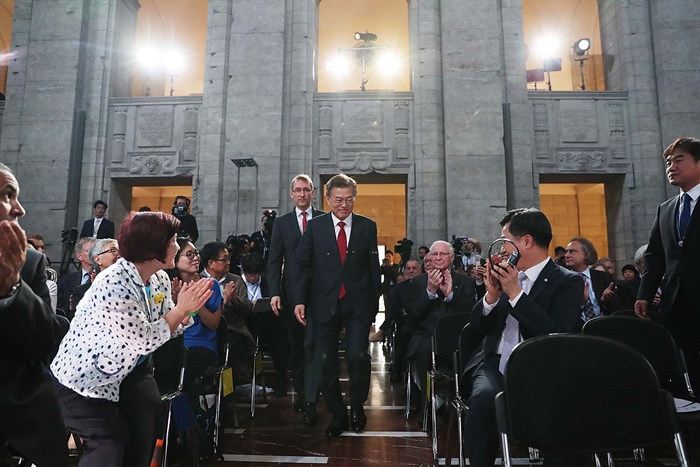
President Moon Jae-in enters Berlin's Old City Hall to speak at the Körber Foundation on July 6. (Cheong Wa Dae)
By Min Yea-Ji and Lee Hana
President Moon Jae-in's decision to announce his New Berlin Declaration in Germany last week has spurred a renewed interest in the link between the European state and the call for Korean reunification.
In his speech at Berlin's Old City Hall on July 6, the president stressed that for Korea, one of the few remaining divided nations on earth, "the fact of Germany's experience gives us hope for reunification, showing us the path we need to follow." and outlined measures for establishing lasting peace, addressing the North Korean nuclear weapons issue, and reuniting separated families.
This is not the first time that a South Korean president has announced plans for reunification while on an official visit to the German capital. A string of former presidents has preceded Moon over the past several decades, delivering messages that outline specific measures to move things forward with North Korea.
South Korea's first state visit to Germany can be traced back to former President Park Chung-hee, who visited West Germany in December 1964. Subsequently, his successors Chun Doo-hwan, Roh Tae-woo and Kim Young-sam all visited the German capital to meet with Helmut Kohl, chancellor of West Germany and of the reunited Germany, to discuss ways to increase cooperation.
In 1995, former President Kim Young-sam received an invitation from a German diplomatic organization to deliver a speech in Berlin. During this address, the president delivered a message of peace, stating that his government was willing to provide aid and necessary supplies to its Northern neighbor.
Five years later, in March 2000, former President Kim Dae-jung delivered a keynote address at Berlin's Free University, with a focus on the lessons that Germany's reunification provide for the Korean Peninsula. The speech, outlining the provision of economic aid to North Korea, the exchange of special envoys across the border, intra-Korean dialogue and reunions between separated families, came to be known as President Kim's Berlin Declaration. The address became the foundation for the meeting between the two sides' envoys, the launch of the historic South-North summit three months later, and the adoption of the June 15th North-South Joint Declaration in Pyongyang.
Former President Roh Moo-hyun returned to Germany in April 2005 and toured the Brandenburg Gate, the monument that separated East Berlin from West Berlin during the years of the Cold War, meeting with German leaders to ask for advice on the reunification process.
Former President Park Geun-hye, meanwhile, visited Dresden in March 2014 and gave an address outlining initiatives for peaceful reunification on the Korean Peninsula.
"Ever since Willy Brandt, the former chancellor of West Germany, took his seat, Germany has pushed policies that stress Wandel durch Annährung, or 'change through rapprochement,'" said Hong Bae Lim from Seoul National University's Institute for Peace and Unification Studies, providing some insight into why so many past Korean presidents chose to announce their ideas about Korean reunification using Germany as a backdrop. "Guided by this philosophy, the Germans were all about consistently maintaining their Neue Ostpolitik, policies that eventually normalized relations between East and West Germany. Germany provides a good example for South Korea for this reason."
Until the momentous day arrives, South Korean heads of state will continue to hope for a peaceful reunification just like in Germany, a country that lived through division and the Cold War to become a champion of progress and unity in Europe.
jesimin@korea.kr